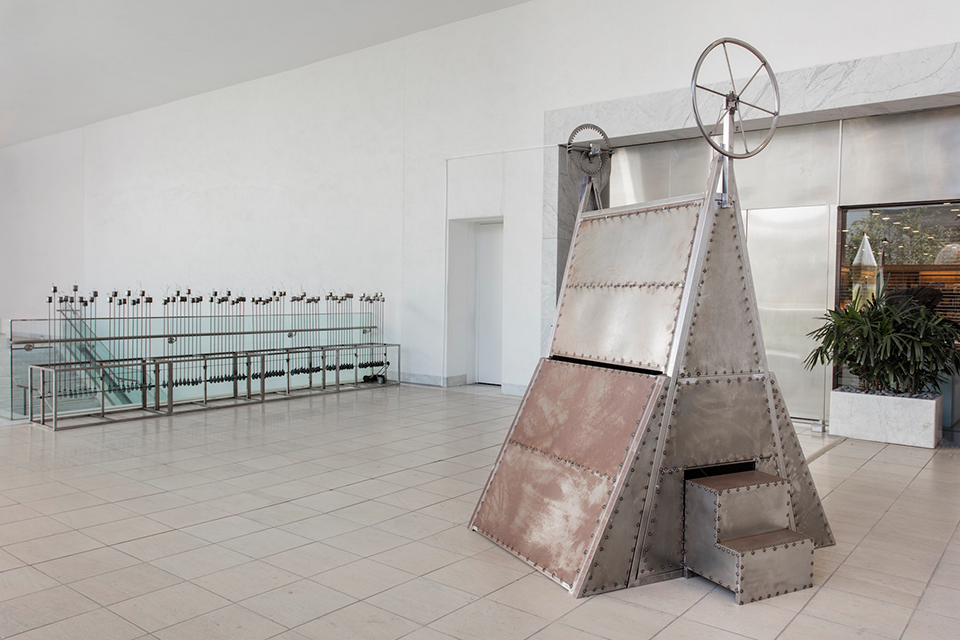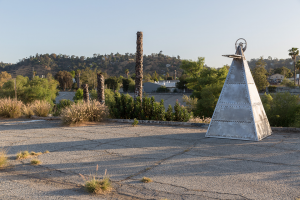Central American Studies Prof’s Sculptures on Display at Hammer Museum and LA River

Beatriz Cortez, installation view, Made in L.A. 2018, June 3 – Sept. 2. 2018, Hammer Museum, Los Angeles. Photo: Brian Forrest, courtesy of the Hammer Museum.
California State University, Northridge Central American studies professor Beatriz Cortez explores the immigrant experience through her art. Her latest pieces, “Tzolk’in” and “Piercing Garden,” are being showcased in the Hammer Museum’s “Made in L.A.” biennial exhibition.
The Hammer is known for its artist-centric and progressive array of exhibitions and public programs in the Los Angeles area.
“It is one of the most important things that has happened in my career,” Cortez said. “There has never been a Salvadoran artist featured in the ‘Made in L.A.’ biennial. This is not only important to me, but it gives a lot of visibility to the experience of Central American migration. Also, through my work I try to celebrate the ability that immigrants have to be in two places at once.”
Two sculptures sit in the Hammer Museum in Westwood, and a second version of “Tzolk’in” is situated at a former rail yard in Glassell Park along the Los Angeles River — at opposite ends of the city. The sculptures are a collaboration between the museum and Clockshop, a multidisciplinary arts organization in LA that creates new conversations about art, politics and urban space.
“Piercing Garden,” part of the “Made in L.A.” biennial, also is on view at the Hammer with her piece “Tzolk’in.”

Beatriz Cortez, Tzolk’in. The Bowtie Project, Los Angeles, Photo: Ian Byers-Gamber, courtesy of Clockshop
The “Tzolk’in” sculptures face each other across the miles, offering audiences the opportunity to reflect on the different realities that exist in these unrelated parts of the city and the ways the locations may be connected, according to Cortez.
“I wanted to do two separate pieces, to talk about living in different parts of the city of LA and because it shows segregation, different opportunities and conditions,” Cortez said. “I also was interested in speaking about divided families and the broken communications through the distance.”
According to L.A. Weekly, the biennial is an important exhibition because all of the artists are selectively chosen from Los Angeles.
“UCLA Hammer Museum curators Anne Ellegood and Erin Christovale visited roughly 200 studios last year on their way to choosing artists for the fourth edition of the museum’s biennial, ‘Made in L.A. 2018,’ a celebration of established and emerging LA-based artists,” the weekly stated.
Cortez’s work was created at the LA welding shop Molten Metal Works. She and her team of artists spent several months fabricating the steel sculptures. Her team had to learn how to weld, and they took classes through Molten Metal Works to perfect the craft, she said.
When the pieces were nearly finished, Cortez said, she needed the gears to have precise teeth to function and spin correctly. She asked several professors of mechanical engineering if they knew someone who could help design the last part of her piece. Guillermo A. Herrera, a CSUN mechanical engineering professor who also happened to be from El Salvador, assisted her with the final creation.
“His help was invaluable,” Cortez said.
Cortez said her work “Tzolk’in” was inspired by the Mayan agricultural calendar and is shaped in a “hypocycloid” motion to mark time through movement that is both linear and cyclical.
Cortez spent a lot of time researching similar motions to that of the Mayan calendar, and she found that a Persian scientist from the 1200s discovered planets in orbit following a similar pattern. Others designed steam engines in England and France during the 1800s with similar hypocycloid motion.
“I thought there was something so powerful about this motion that the Maya had used to design their calendar,” she said. “It was cosmic and biological, and a part of the industrial revolution and something spiritual.”
The “Piercing Garden” sculpture at the Hammer has a shaft that transforms circular into linear motion. Every 20 minutes, a motor in the piece sends a row of steel cups of spouts up and down on welded rods, all at different speeds.
Cortez said that the sculpture at the river moves for whoever is there to view it. The artwork performs for wildlife, passersby and the river itself. The piece is on a timer, and the motions are activated every 30 minutes for part of the day. The site is equipped with a camera to record the surrounding areas and the people who come to view the piece. The videos are recorded and sent to the Hammer, where they can be seen by visitors to the “Tzolk’in” installation.
“One could say that the two machines are communicating with each other,” Cortez said.
The project is a collaboration between the Hammer Museum and The Bowtie Project — a partnership between Clockshop and California State Parks to activate an 18-acre post-industrial lot along the LA River.
The current “Made in L.A.” exhibition runs through Sept. 2.

 experience
experience